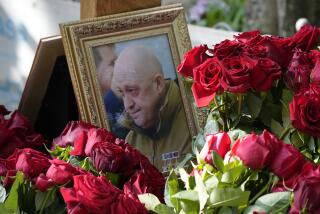Safety Board Blames Pilot for Fatal USAir Accident : Aviation: Officials say his failure to spot a rudder error caused the jet to skid into a N.Y. river. His actions in aborting the takeoff also are criticized.
- Share via
WASHINGTON — The National Transportation Safety Board said Tuesday that the pilot of USAir Flight 5050 probably caused his jetliner to skid into New York’s East River, killing two passengers.
The board, ruling 4 to 0, said that pilot Michael Martin made several mistakes while attempting to take off from La Guardia Airport on Sept. 20, 1989, and then in aborting the takeoff.
Among the errors, the NTSB said, were:
--Martin’s failure to detect an improperly positioned rudder trim control. When correctly set, the control puts the rudder in a neutral, or straight back, position. The knob on Martin’s Boeing 737 had somehow been set to full left rudder.
--His failure to realize that, even with the knob incorrectly set, he could have taken off by adjusting other controls.
--His failure to carry out standard precautions and procedures for aborting a takeoff.
The plane skidded off the runway and landed in the river, splitting apart. The 61 survivors were rescued from the river.
The Air Line Pilots Assn. called the board’s determination of probable cause in the accident “a total travesty” and said it would ask the NTSB to reconsider its finding.
NTSB board member John Lauber said investigators had been reluctant to lay all of the blame for the accident on Martin. But Lauber said that the pilot’s performance on the La Guardia runway showed so many lapses that the decision was justified.
The board in the past has found 90 incidents on 737s in which the trim-control knob had been incorrectly set.
Boeing and safety officials have determined that the knob could be accidentally moved by cockpit visitors who put their feet on the console between the pilot and co-pilot or by laying a book or other object on the console.
Boeing and the Federal Aviation Administration have called for changes in the trim-control knobs on all of the more than 600 Boeing 737s in use.
The NTSB said also that Martin used poor judgment in letting co-pilot Constantin Kleissas attempt the takeoff on a dark, rainy night, even though he was certified to fly the plane.
As the plane’s speed increased, it began drifting to the left, at which point Martin told Kleissas that he was taking the controls and aborting the takeoff. But the NTSB said Martin had not made himself clear and Kleissas was not sure what was happening.
Once the decision to abort was made, the board said, Martin improperly tried to control the plane by steering with the nose wheel instead of the rudder.
In addition, investigators said the pilot had failed during preparations for the flight to ensure that the plane’s automatic braking system was set to engage if the takeoff was aborted.
Bob Benzon, the NTSB investigator in charge of the inquiry, said simulator tests had shown that, with proper pilot decisions, the plane could have stopped safely on the runway or could have taken off, even with the rudder error.
The licenses of Martin and Kleissas have been suspended by the FAA, which was critical of their failure to appear for drug tests after the accident. Both, however, have dropped their appeals of the suspensions and can fly again if they pass recertification tests.
More to Read
Sign up for Essential California
The most important California stories and recommendations in your inbox every morning.
You may occasionally receive promotional content from the Los Angeles Times.













